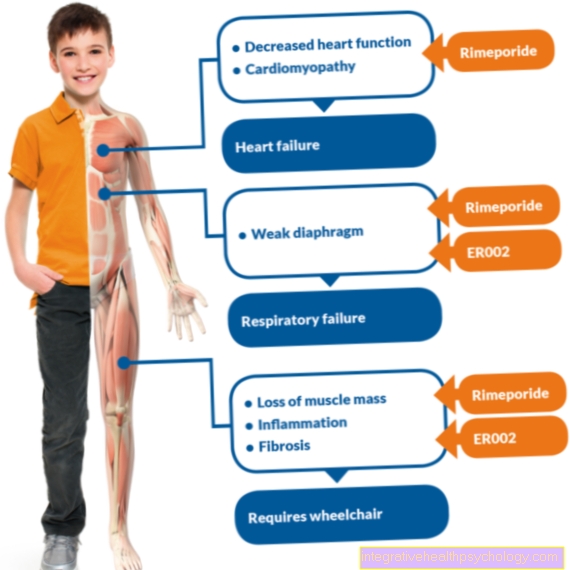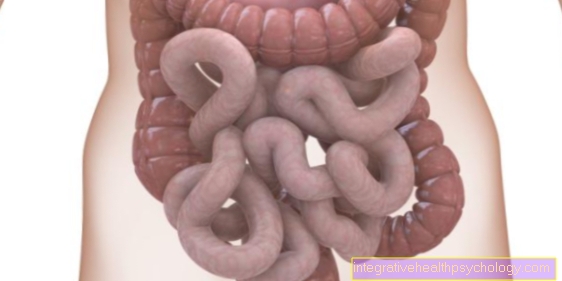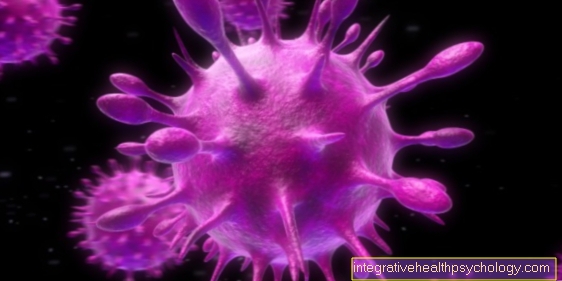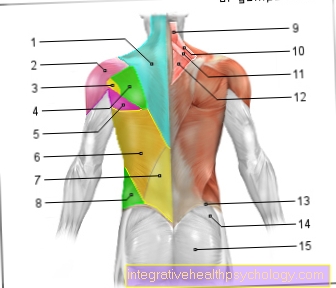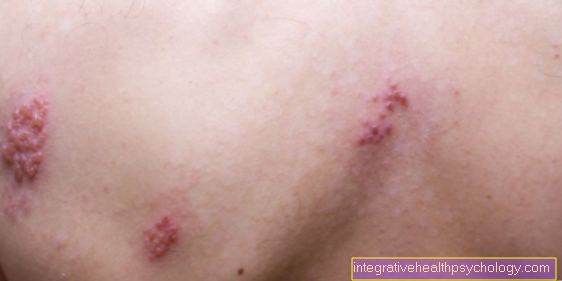Spermatic neuralgia
What is spermatic neuralgia?
Neuralgia describes an attack-like, shooting pain in the area of a single nerve. In this case, the term “spermaticus” refers to the male spermatic cord, which experts call “Fasciculus spermaticus”. A nerve, the genitofemoral nerve, runs through this spermatic cord.
This is responsible for skin sensations in the groin region as well as on the scrotum.
Damage or irritation to this nerve is responsible for the symptoms of spermatic neuralgia, which is why the more correct term would actually be "genitofemoral neuralgia". According to the previous considerations, the term spermatic neuralgia describes attack-like pain in the groin and scrotum.
Women are not immune to spermatic neuralgia either, because although they do not have a spermatic cord, they do have a genitofemoral nerve. They experience pain in the groin and the labia majora.
Learn more about: neuralgia

causes
In principle, any kind of damage to the genitofemoral nerve can lead to spermatic neuralgia.
Accordingly, in rare cases, inflammatory nerve diseases such as Guillain-Barré syndrome can manifest themselves in the form of spermatic neuralgia.
More often, however, it is tumors or abscesses (encapsulated collections of pus) that attack the nerves. In addition, the nerve can also be injured during surgery on inguinal hernias. In this case one speaks of an iatrogenic (caused by the doctor) spermatic neuralgia.
Often, however, no clear cause for the disease can be identified, which makes therapy much more difficult.
Find out more about: Tumor diseases
diagnosis
The diagnosis of spermatic neuralgia is made by the doctor based on the patient's descriptions. There is currently no specific method for examining the genitofemoral nerve, but this is usually not necessary due to the very clear symptoms of the disease.
Nonetheless, the diagnosis of spermatic neuralgia should entail instrumental examinations aimed primarily at discovering an abscess or tumor as a possible cause.
First of all, an ultrasound examination and, if necessary, imaging methods such as computed tomography (CT) or magnetic resonance imaging (MRT) are suitable for this.
You can find detailed information on this topic at: Ultrasound of the testicle
Concomitant symptoms
Spermatic neuralgia usually manifests itself in attack-like, shooting pain in the groin and scrotum or, in the less often affected women, in the groin and large labia. In addition, in men with spermatic neuralgia, the so-called cremaster reflex is often weakened or completely absent.
This can be checked by gently wiping the skin on the inside of the thigh: In healthy people, this leads to the cremaster muscle (hence the name of the reflex) lifting the testicle on the same side towards the abdomen, which can be interpreted as a protective measure.
In patients with spermatic neuralgia there is no or only a very weak reaction. Since the extent of the reaction is difficult for the layperson to assess, it should be left to a medical professional to evaluate it.
Read more on the topic: Kremaster reflex
treatment
If the spermatic neuralgia is based on a clearly definable cause (e.g. tumor or abscess), its removal is the focus of therapy. In most cases, a tumor is surgically removed, while most abscesses can be emptied outwards through a targeted puncture (piercing).
If this does not lead to complete freedom from symptoms or if no such cause has even been discovered, an attempt can be made to achieve an improvement through regular injections of local anesthetics (local narcotics).
Alternatively, carbamazepine or baclofen can be used, which are proven agents for treating nerve pain of various causes.
You can find out more about the topic here: Carbamazepine
Duration
The duration of a spermatic neuralgia varies greatly from person to person. In the case of clearly defined causes (e.g. tumor or abscess), their elimination can often lead to immediate improvement and early freedom from symptoms.
If, however, no cause can be identified, local anesthetic therapy is usually started first. The local anesthetics reliably remove the pain immediately after their injection, but it often comes back when the effect of the drugs wears off.
If this is the case, alternatively baclofen or carbamazepine can be used, although the optimal dose is often only found after a few readjustments. In this way, it can sometimes take a few weeks to several months before the doctor and patient can get the spermatic neuralgia under control and, at best, even completely forget it.
forecast
The prognosis of spermatic neuralgia strongly depends on whether a cause for the nerve damage to the genitofemoral nerve has been found.
If it is an abscess, it can usually be relieved relatively easily with a needle puncture and the symptoms usually disappear immediately and permanently.
If a tumor is the basis of spermatic neuralgia, its removal usually effectively relieves pain symptoms. But the long-term general prognosis is of course highly dependent on the stage of the tumor and the question of whether the tumor is benign or malignant and whether it has already metastasized (spreading ulcers).
If, on the other hand, no clear cause of the spermatic neuralgia can be identified, formulating a prognosis is even more difficult: some sufferers try different treatment methods and drugs for years, more or less unsuccessfully, while others are permanently symptom-free after the first local anesthetic injections.











